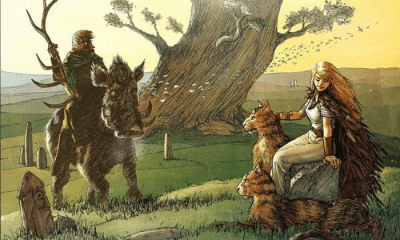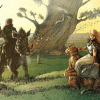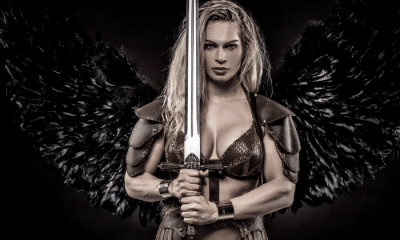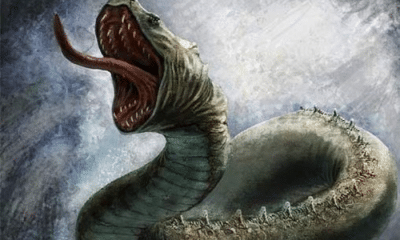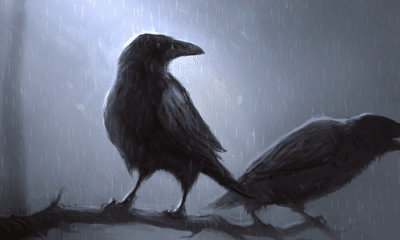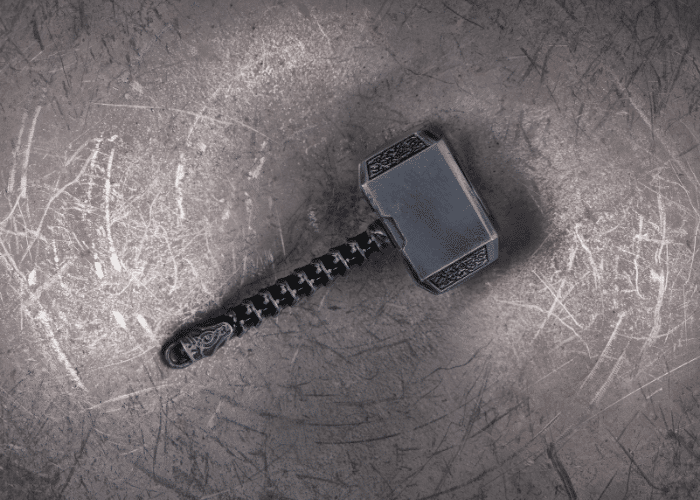
Norse
Mjölnir: Thor’s Hammer
Mjölnir: Thor’s Hammer
Keep reading to learn more about Mjölnir, the hammer that gave Thor many of his powers!
In the Norse world, it was not only people and places that had names. Items of value were named as well, and many of these items are nearly as famous as the people who wielded them.
One of the most powerful and well-known artifacts of the Norse gods was Mjölnir, the war hammer that was wielded by the god of thunder. Thor used this remarkable weapon to such an extent that it became his most identifiable attribute.
Eventually, Mjölnir became a symbol of more than just Thor. It came to stand for the entire Norse faith and everything they believed in.
So how did a hammer become such an important part of the culture?
Thor’s Thunder Weapon
Thor was an example of a common archetype in many religions. Like Zeus, Indra, and Jupiter he was a thunder god.
These gods had a great deal in common, including their short tempers and connections to rule. Another thing they had in common was that they often used weapons as part of their storms.
For Zeus and Jupiter, the thunderbolts themselves were weapons. They threw them like javelins at those who angered them, striking with great force and precision.
In Hebrew, the Bible describes the old testament god as using “arrows” against his foes.
Thor had one of the most iconic and impressive thunder weapons in recorded mythology. He wielded a powerful hammer called Mjölnir.
Many linguists believe that Mjölnir’s name was derived from the word for a grindstone, perhaps to invoke the sound of thunder. Some also believe that Mjölnir’s origins may not have been as the type of tool that is generally imagined.
Mjölnir is usually shown as a large war hammer, a weapon that would be used to crush enemies on the battlefield. In writing, it is called a hammar.
While hammar was the word for a hammer, it could also be used in reference to different types of stone. In both Old Norse and some modern Nordic languages, it can mean “stone” or “cliff.”
This goes back to a time long before the Viking Age when the tools and weapons of early Europeans were made of stone rather than metal. While the materials changed over time, the language still reflected Neolithic technology.
It is possible, then, that an early version of Mjölnir was not a hammer at all. Instead, it could have been a tool or weapon made of stone whose name, from the word for a grindstone, would have matched both its form and the sound it made.
How Mjölnir Was Made
While the marriages and births of the Norse gods were poorly attested, how they got their most famous weapons was much more well-known.
The legend of Mjölnir’s creation began, as many Norse myths did, with a trick played by Loki.
Thor’s wife Sif was known for her beautiful, flowing blonde hair. One night while she slept, Loki cut off her magnificent locks.
When Sif awoke to find her hair cut short, Thor was outraged. He threatened to break every bone in Loki’s body if a solution could not be found.
Loki said that he could go to Svartálfheim and have new hair made for the goddess. It would grow like real hair but, he said, would be even better because it would be made of real gold.
Thor agreed to let Loki go, but the trickster knew that the punishment would be severe if he could not deliver on his promise.
A group of dwarves, the sons of Ivaldi, created new hair for Sif that was as lovely and realistic as Loki had promised. They also gave him two additional gifts to take to the gods of Asgard.
Loki, who always tried to get the upper hand, realized that he might be able to bring even more gifts back from the dwarves. The more wonders he could deliver to the gods, the more good will he would earn from them.
So the trickster went to two brothers, Brokkr and Sindri, with the three remarkable items he had been given. He bet the two that they could not create gifts for the gods that would match these in quality and beauty.
Loki was so confident that he bet his own head again the skill of the dwarves. Of course, he intended to cheat Brokkr and Sindri out of their work.
As Brokkr worked the forge, a fly bit him on the arm. Undeterred, he made a boar with golden hair.
As the brother made a magical golden ring, the fly bit one of them on the neck. Although the bite was painful, he was not distracted from his work.
When the two began to create their final gift, the fly bit Brokkr’s forehead. Blood dripped into his eyes, clouding his vision as he worked.
The fly was Loki in disguise. By blinding Brokkr, he felt sure that he had won the bet.
Mjölnir, their final creation, was an amazing weapon. It could strike any surface without breaking, would always hit its target, and when thrown would return to the user’s hand after it struck.
However, because Brokkr had been blinded by the fly’s bite, the hammer’s handle was slightly too short. The weapon was powerful and embued with strong magic, but it was slightly off balance.
Loki returned to Asgard and happily presented the gods with his gifts. Thor accepted Sif’s new hair and Mjölnir, forgiving Loki for his previous crime.
Soon, Brokkr and Sindri came to Asgard to collect their prize. They were certain that the gods would be pleased with their gifts and they would win the right to cut off Loki’s head.
Loki argued that Mjölnir was slightly imperfect, so the brothers had actually lost the bet. The gods disagreed; Thor was so pleased with Mjölnir that he agreed to give the dwarves Loki’s head.
A final act of trickery saved Loki from a beheading. He said that he had told the dwarves that they could take his head but not any of his neck.
The dwarves and the gods talked at length about how to determine where Loki’s head began and his neck ended, but no clear division could be seen. Because they could not take even a fraction of his neck, the dwarves were forced to give up their claim to Loki’s head.
As a compromise, the gods allowed Brokkr and Sindri to sew Loki’s lips together with a piece of leather. While he kept his head, Loki learned that his clever words could have serious consequences.
The Theft of Thor’s Hammer
Another poem showed the value Thor placed on his hammer. When Mjölnir was stolen from him, the god went to great lengths to win it back.
When Thor awoke one morning to find his hammer missing, he and Loki immediately went to Freyja for assistance. Borrowing her feathered cape, they flew to Jötenheim to find it.
There, they met a giant called Thrym (Þrymr). He claimed that he had hidden Mjölnir and would only return it if Freyja were brought to Jötenheim to be his wife.
Thor told Freyja to prepare for the marriage, but she flew into a rage. The other gods agreed with her that they would not trade a goddess for Thor’s weapon, but that they needed it back before the giants used its power against them.
The gods met to find a solution and Heimdall, who like the Vanir could foretell the future, suggested that Thor ought to go to Thrym’s hall in disguise. He said that Thor should dress as a woman and pretend to be Freyja to get access to the hammer.
Thor refused because such a ploy would lead to ridicule, but Loki volunteered to join him. The trickster would put on the guise of a maid to accompany the ”goddess.”
Thor reluctantly went along with the plan and he and Loki were welcomed into Thrym’s hall. They wore heavy veils and jewelry to hide their faces from the giants.
Thrym threw an elaborate wedding feast in Freyja’s honor. He grew suspicious, however, when he saw the “bride” eat eight salmon and drain three casks of mead.
Loki claimed him by claiming that Freyja had been so excited that she had not slept in eight nights. He further explained Thor’s angry gaze by saying that Freyja’s eyes were bloodshot because she had not slept in anticipation.
Thrym’s sister asked the “bride” for gifts as the giant ordered Mjölnir to be brought out. He would lay it in Freyja’s lap to consecrate the marriage ritual.
As soon as Mjölnir was brought into the hall, Thor lept into action.
When Thor saw the hammer his heart laughed within him, and he took courage. He first slew Thrym, the lord of giants, then he crushed all the giant’s kin. Finally he slew the old giantess who had begged for a bridal gift. Instead of coins she got the crack of the hammer. Instead of rings she received the mark of Mjöllnir. Thus Thor won back his hammer.
-Poetic Edda, þrymskviða (trans. Ashliman)
Norse culture placed a taboo on “womanly” behavior among its warriors. Dressing as Freyja for a sham wedding was an extreme length for Thor to go to, especially as a god who was generally quick to challenge others to a fight.
The story illustrates how important Mjölnir was in Norse mythology. All the gods of Asgard worked to find a solution because they feared that such a powerful weapon could be used against them if Thor did not get it back.
Other Famous Weapons of the Gods
Mjölnir was important to the gods, but it was not the only magical weapon they possessed.
Many magical artifacts and even animals were named in Norse mythology. They helped the gods get out of trouble, augmented their powers, and increased their wealth.
Odin’s ring Daupnir, for example, was one of the items made by Brokkr and Sindri. Every nine nights it would make duplicates of itself, constantly giving Odin more gold.
The chains that were used to bind the wolf Fenrir were given names, even those that snapped when he strained against them. The final binding, Gleipnir, was as light as a ribbon but crafted with the magic of the dwarves.
The most remarkable and powerful artifacts of the gods, however, were their weapons. Mjölnir was named as the best when Loki brought it out of Svartálfheim, but other items were notable as well.
- Gungnir – Odin’s spear was crafted by the sons of Ivaldi. Like Mjölnir, it always struck its target. It was also used to consecrate battlefields, making the fighters who died blood sacrifices to its owner.
- Hofuð – Meaning “Head,” this was the sword of Heimdall.
- Mistiltainn – Because Baldr could not be harmed by conventional weapons or any living thing, Loki fashioned an arrow out of the only plant that had not sworn to keep him safe. The magical mistletoe arrow was shot by the blind god Hóð.
- The Sword of Freyr – Although unnamed, the sword was renowned for its ability to kill any foe. Freyr traded it away to marry the giantess Gerðr and, without the help of its abilities, would die in his fight against Loki at Ragnarök.
- Meginjörð – Although not a weapon, Thor’s belt was vital to his ability to fight. It doubled his already impressive strength, giving him the power to fight otherwise impossible enemies.
The Fate of Thor’s Hammer
Thor’s hammer was his most recognizable attribute, the most powerful weapon in Asgard, and the source of the thunder he created. However, it was not destined to be his forever.
When Ragnarök began, Thor would take his hammer into battle. There, he would face a foe he had encountered before.
In at least one other myth, Thor had attempted to kill Jörmungandr. The great world serpent was so large that his body completely encircled Midgard, but Thor had once been able to pull his head onto a small fishing boat and begin beating him with Mjölnir.
Thor was not able to kill the monster, however, because his companion on that adventure was too afraid of it. Hymir cut the fishing line that had caught Jörmunganðr and the serpent escaped.
When the last battle of the gods began, Thor and the world serpent would once again face one another.
That battle would be one of the most violent and brutal of Ragnarök. Thor possessed remarkable strength and a powerful weapon, but Jörmungandr’s sheer size made him a deadly opponent.
Eventually, Thor and Mjölnir would prove stronger. The serpent would fall on the battlefield and Thor would walk away to help his father, Odin, fight off Fenrir.
Thor would only take nine steps, however. On the last one, Jörmungandr’s venom would overtake him and he, too, would fall dead on the field.
Not all of the gods would die in this battle, however. Two of Thor’s sons, Magni and Móði would find Mjölnir on the destroyed battlefield and take it up for themselves.
The brothers would share Mjölnir as the surviving gods rebuilt Asgard and the world of men was slowly repopulated. While Thor would not survive the twilight of the gods, his hammer would make it through unscathed and become a symbol for a new generation of gods.
The Symbolism of Mjölnir
Mjölnir was a practical weapon for a thundering warrior like Thor to carry, but historians believe it also served a symbolic purpose.
Throughout Scandinavia, archaeologists have uncovered small amulets in the shape of Thor’s hammer. They are numerous enough to show that they were common in the Viking world.
These amulets are likely a type of protective charm. By wearing the image of Thor’s weapon, Norse people could hope to gain the god’s favor and perhaps a fraction of his strength.
As the god of storms, Thor was also connected to ideas of fertility. The rain that accompanied his thunder fertilized the soil, allowing crops and wild plants to grow.
Because of this, some historians believe that Thor’s hammer may have also served as a fertility charm. Whether to ensure a good harvest or in the hopes of having children, Norse people may have believed that Thor could help them in peaceful pursuits as well as in battle.
Mjölnir may have been linked to concepts of fertility long before Thor’s legends were written down.
Neolithic carvings in Northern Europe show two figures standing before a larger one that is holding a hammer. The scene would be impossible to decipher with any accuracy if it did not seem to have a parallel in a well-known Norse myth.
When Thor disguised himself as Freyja, Thrym said that he was going to use Mjölnir to consecrate the image. The divine weapon would be laid in the bride’s lap to complete the marriage ceremony.
Some historians believe that the hammer, as a symbol of a god, was used in this way throughout European history. The Stone Age image may be the first representation of a religious ceremony that was mentioned by a medieval poet thousands of years later.
Mjölnir was such an important symbol in Norse religion that it came to symbolize paganism itself.
By the Viking Age, it was common for Christians in Europe to wear a cross on their neck or belt as a symbol of their faith. There is some evidence that the Norse pagans who lived alongside them used Thor’s hammer in a similar way.
A 10th-century jeweler’s mold found in Denmark has three sections for creating amulets. Two are Christian crosses while the third is in the shape of Thor’s hammer.
This is not only evidence of pagans and Christians living side by side and artisans serving both communities, but also that Thor’s hammer was used in a similar way and in similar demand to the Christian cross.
Larger artifacts show a similar usage of the hammer symbol. As Christianity spread, the cross began to appear on many runestones in Scandinavia. At about the same time, others showed Mjölnir in the same position.
Historians believe that pagans used Mjölnir as a visible symbol of their faith in the same way that the Christians around them used the cross. For the relatively short period of time that medieval pagans and Christians lived alongside each other, both used prominent symbols to signal their beliefs.
Of course, Germanic paganism died out in Europe during the medieval era. While some elements remained in folklore and tradition, belief in the Norse gods gave way to Christianity.
Mjölnir was one of the symbols that at least partially survived the Christianization of Northern Europe. While the people there no longer worshiped the Norse gods, in some areas hammer charms continued to be placed alongside the first seeds sewn each spring to ensure fertility.
In recent years, however, Thor’s hammer has begun to see a more visible resurgence as a religious symbol.
While not all modern neopagans worship Norse or Germanic gods, a growing number of people have begun to profess faith in the pantheons of their ancestors. Once again, people are using Mjölnir as a symbol of their religion.
In Nordic countries, Thor’s hammer is both an expression of modern paganism and of national heritage. In parts of Germany, Thor’s hammer is used as the official symbol of local paganism even though it originally developed outside of the region.
Mjölnir today is used as a symbol by a small number of pagans even in countries that were never part of the Danelaw. In the United States and the Netherlands, for example, some pagan groups name Thor among their gods and use his symbol.
The Importance of Thor’s Hammer
In Norse mythology, Thor’s hammer was one of the most important items owned by the gods.
Named Mjölnir, it was crafted by two dwarves named Brokkr and Sindri. Because Loki distracted them in the form of a fly the handle was slightly too short to be perfect, but Thor and the other Aesir gods still claimed that it was the most wondrous and powerful item any of them owned.
Mjölnir was strong enough to strike any object or surface without ever breaking. It would always hit its intended target and then fly back to Thor’s hand when it was thrown.
The hammer also created lightning. Thor was a sky and storm god and, like many of that archetype, used his weapon to both summon storms and strike down his enemies.
Mjölnir played an important part in many of Thor’s myths. When it was stolen, for example, he was willing to risk shame and mockery by dressing as a woman and sitting through a wedding feast with a giant to regain it.
Thor’s final use of his famous hammer would be at Ragnarök, when he would use it to finally kill the great world serpent. He would succumb to Jörmungandr’s venom moments later and his two surviving sons would take Mjölnir when they helped to rebuilt Asgard.
Thor’s hammer was an important symbol in the Norse world. It was used to invoke the god’s blessing both in fighting and warfare and in peaceful pursuits. Because he was connected to fertility as a sky god, Thor’s symbol was used to sanctify marriages, promote fertility, and ensure a good harvest.
In the Christian era, the hammer was used as a symbol of faith in the same way as the cross. This continues even today, as a small number of neopagans use Thor’s hammer as a symbol of their religion in both casual and official contexts.


